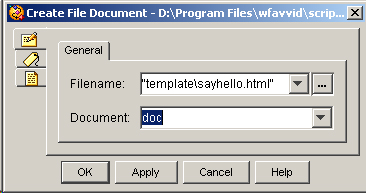The Create File Document Step
Add a Create File Document step to the hello.aef script to create a file document that represents the HTML template sayhello.html. You will then use this file document in the Keyword Transform Document step.
To create this file document, do the following:
Procedure
| Step 1 | From the Document palette in the Palette pane, drag a Create File Document step to the Design pane, and then drop it over the Get Http Contact Info step icon. The Create File Document step icon appears in the Design pane, just below, and on the same level as, the Get Http Contact Info step icon. | ||
| Step 2 | Right-click the new Create File Document step icon. A popup menu appears. | ||
| Step 3 | Choose Properties. The Create File Document customizer window appears.  | ||
| Step 4 | In the Filename text field, enter the following file name, as shown in figure: “template\sayhello.html” This pathname is a relative pathname that uses a predefined subdirectory within the installationdirectory. When you implement a real application in a production environment, make sure that the file and pathname work on the production server. | ||
| Step 5 | From the Document drop-down menu, choose the variable doc, as shown in figure. This variable contains the document to be sent in response to the user. | ||
| Step 6 | Click OK. The Create File Document customizer window closes. You are now ready to add the next step to the hello.aef script in the Design pane of the Cisco Unified CCX Editor.
|